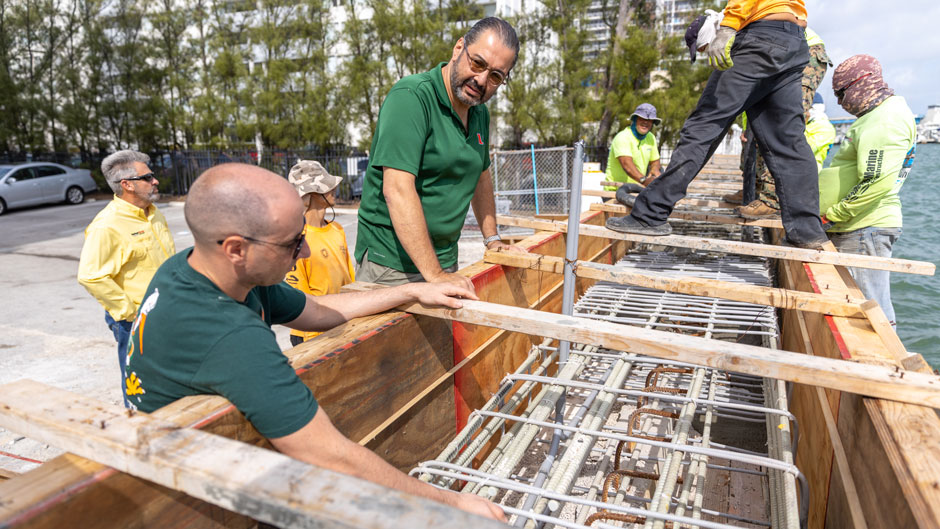South Florida scored a victory in its fight against climate change earlier this year when it received the lion’s share of $275 million in state funds earmarked to help coastal and inland communities prepare for the impacts of flooding and storm surge.
The region’s take from the lucrative pot: $180 million.
For Miami-Dade County, which two years ago unveiled its ambitious plan of infrastructure upgrades to adapt to sea level rise, the cash will come in handy—funding projects that range from protecting a wastewater treatment plant vulnerable to storm surge to raising the banks of the C-8 canal in North Miami.
While such upgrades are helping the county become more resilient, they also are having another effect: increasing the value of single-family residential homes and condominiums located in the vicinity of those projects, a study by two University of Miami researchers has revealed.
After examining records from both the Miami-Dade Property Appraiser’s Office and the county’s Office of Resilience, the researchers discovered that homes and condos within 200 meters of climate-related infrastructure projects such as seawall repairs, roadway elevations, and reservoir installations sold at higher prices and increased in value by nearly 10 percent, five years after those projects had been completed.
“About half of the effect is present after one year, indicating that the value of projects is incorporated into property values slowly over time,” the researchers wrote. The study found that projects that were more visible, such as road elevations, had a greater impact on property values compared to less visible projects like pumping stations. But while such are not easily observed by buyers and sellers in property markets initially, they become more apparent after reductions in flooding events occur over time, according to the researchers.
“Our major finding is that public investment on climate adaptation is viewed as a benefit, at least by residents of Miami-Dade,” said the study’s co-principal investigator Renato Molina, an assistant professor of environmental science and policy at the Rosenstiel School of Marine, Atmospheric, and Earth Science. “People understand that improvements like seawalls and expanded greenspaces create protection.”
For the study, Molina and David L. Kelly, a professor of economics and co-chair of the Sustainable Business Research Cluster at the Miami Herbert Business School, reviewed more than 400,000 property transactions conducted between 2000 and 2019. They also studied data on 162 climate adaptation infrastructure projects, most of which were completed between 2014 and 2016.
Their study, Adaptation Infrastructure and Its Effects on Property Values in the Face of Climate Risk, is published in the November issue of the Journal of the Association of Environmental and Resource Economists.
Funded by the University of Miami Laboratory for Integrative Knowledge, or U-LINK, the study also calculated the return on investment for adaptation infrastructure projects in the county.
“Miami-Dade is a dense urban environment, and so most projects are surrounded by hundreds or thousands of properties, which leads to relatively large aggregate net benefits across the county,” Molina and Kelly wrote. “As most projects generated positive net benefits, this pattern indicates that the majority of projects are being placed in areas that pass the benefit-cost test.”
Property buyers, sellers, and local governments not only are aware of the risks posed by sea level rise, tropical cyclones, and other climate-related impacts but they also believe that infrastructure projects can alleviate those threats, the study found. “The implication is that the local community is able to overcome coordination barriers at least enough so that most projects have benefits reflected in property values that exceed construction costs,” the researchers wrote.
The study comes as some climate models predict two feet or more of sea-level rise for Miami-Dade by the year 2060.
“There’s a lot of debate over whether the county can be protected and how well it can be protected,” Kelly said. “If you talk to the county, they’ll tell you, ‘Okay, we have a plan, and our belief is that we can protect it.’ They believe that, in fact, some of these [infrastructure] projects have a benefit cost-ratio of four to one, which basically means you put in $1 to the project, you get $4 back.”
While the accuracy of those numbers is disputed in the study, Kelly noted that the county nevertheless is placing such projects in areas of need. “So, we do see the benefits of that, as measured by the higher property values,” he explained.
Although the county and other municipalities may be on the right track in adapting to the effects of climate change, they may have to adjust in the future, as some of the infrastructure projects are only small-scale in nature, designed to deal with sea level rise and other impacts for perhaps the next 30 years, according to the researchers. “They’re going to have to build more levels of protection after that,” said Molina, who holds a secondary appointment in the Department of Economics. “But for the short to medium term, they’re on the right track with their solutions.”
The study also raises concerns about potential environmental gentrification, where increased property values and rents could displace low-income residents. “That’s our follow-up project to this study—to learn how these adaptation infrastructure projects might affect the makeup of a neighborhood,” Molina said.

